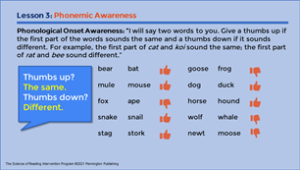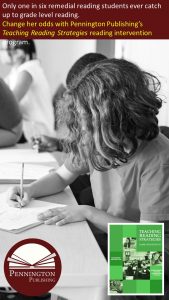Phonemic Awareness Activities
Get ready for some terrific phonemic awareness activities… But first, let’s get clear on just what phonemic awareness is all about, why it is important, and how it relates to reading. Phonemic awareness is the basic understanding that spoken words are made up of individual speech sounds. We call these speech sounds phonemes. There are about 43 common phonemes in English. See my attached list, Phonemes, which includes adjustments for the Spanish phonemes in footnotes.
Why is phonemic awareness essential?
Between 20 and 40% of the population does not naturally develop phonemic awareness. Research indicates that there may be both medical and genetic factors that contribute to this deficiency (Grossen, 1997).
When children cannot hear and manipulate the sounds (phonemes) in spoken words, they struggle learning how to attach these sounds to letters and letter combinations. Lack of phonemic awareness is the chief causal factor of reading disabilities (Adams, 1990). In fact, phonemic awareness is the best predictor of reading success (Goldstein, 1976; Zifcak, 1977; Stanovich, 1986, 1994).
Phonemic awareness relates to reading in two ways: (1) phonemic awareness is a prerequisite of learning to read (Juel, Griffith, & Gough, 1986; Yopp, 1985), and (2) phonemic awareness is a consequence of learning to read (Ehri, 1979; Read, Yun-Fei, Hong-Yin, & Bao-Qing, 1986).
Can phonemic awareness be remediated?
Yes, but the older the child, the more challenging it is to learn phonemic awareness. See my article titled Should We Teach Phonemic Awareness to Remedial Readers? on remediating phonemic awareness to check out the reading research and instructional solutions.
What about English-language Learners?
It’s true that specific speech sounds differ among languages, and this makes phonemic awareness and phonics acquisition more challenging for English-language Learners (ELs). However, EL students and English-language Development (ELD) students are certainly able to transfer their phonological awareness skills from their primary language to English, and research indicates the positive benefits of phonemic awareness training (Abbot, Quiroga, Lernos-Britton, Mostafapour, and Berninger, 2002). Indeed, some primary languages, such as Spanish, share more phonemes with English than not.
Phonemic Awareness Assessments
Not all students will have mastered the same components of phonemic awareness. Thus, diagnostic assessments are a must to efficiently teach these unmastered components. After completing phonemic awareness assessments, grade and record any unmastered phonemic awareness components for each student on a progress monitoring matrix. An excellent set of six whole-class phonemic awareness assessments with recording matrix is provided free for classroom use at www.penningtonpublishing.com. 
Phonemic Awareness Instructional Sequence and Workshop Activities
Differentiate instruction, according to the diagnostic data in small group reading workshops. There is an instructional order that makes sense. I suggest that you teach your phonemic awareness workshops in this order:
- Rhyming Awareness
- Alphabetic Awareness (Make sure to check out the Mp3 “New Alphabet Song” for both beginning and struggling readers found in the phonemic awareness activities packet.)
- Syllable Awareness and Syllable Manipulation
- Phonemic Isolation
- Phonemic Blending
- Phonemic Segmentation
*****
The Science of Reading Intervention Program
The Science of Reading Intervention Program: Word Recognition includes explicit, scripted instruction and practice with the 5 Daily Google Slide Activities every reading intervention student needs: 1. Phonemic Awareness and Morphology 2. Blending, Segmenting, and Spelling 3. Sounds and Spellings (including handwriting) 4. Heart Words Practice 5. Sam and Friends Phonics Books (decodables). Plus, digital and printable sound wall cards and speech articulation songs. Print versions are available for all activities. First Half of the Year Program (55 minutes-per-day, 18 weeks)
The Science of Reading Intervention Program: Language Comprehension resources are designed for students who have completed the word recognition program or have demonstrated basic mastery of the alphabetic code and can read with some degree of fluency. The program features the 5 Weekly Language Comprehension Activities: 1. Background Knowledge Mentor Texts 2. Academic Language, Greek and Latin Morphology, Figures of Speech, Connotations, Multiple Meaning Words 3. Syntax in Reading 4. Reading Comprehension Strategies 5. Literacy Knowledge (Narrative and Expository). Second Half of the Year Program (30 minutes-per-day, 18 weeks)
The Science of Reading Intervention Program: Assessment-based Instruction provides diagnostically-based “second chance” instructional resources. The program includes 13 comprehensive assessments and matching instructional resources to fill in the yet-to-be-mastered gaps in phonemic awareness, alphabetic awareness, phonics, fluency (with YouTube modeled readings), Heart Words and Phonics Games, spelling patterns, grammar, usage, and mechanics, syllabication and morphology, executive function shills. Second Half of the Year Program (25 minutes-per-day, 18 weeks)
The Science of Reading Intervention Program BUNDLE includes all 3 program components for the comprehensive, state-of-the-art (and science) grades 4-adult full-year program. Scripted, easy-to-teach, no prep, no need for time-consuming (albeit valuable) LETRS training or O-G certification… Learn as you teach and get results NOW for your students. Print to speech with plenty of speech to print instructional components.
SCIENCE OF READING INTERVENTION PROGRAM RESOURCES HERE for detailed product description and sample lessons.
FREE DOWNLOADS TO ASSESS THE QUALITY OF PENNINGTON PUBLISHING RESOURCES: The SCRIP (Summarize, Connect, Re-think, Interpret, and Predict) Comprehension Strategies includes class posters, five lessons to introduce the strategies, and the SCRIP Comprehension Bookmarks.
FREE DOWNLOADS TO ASSESS THE QUALITY OF PENNINGTON PUBLISHING RESOURCES: The SCRIP (Summarize, Connect, Re-think, Interpret, and Predict) Comprehension Strategies includes class posters, five lessons to introduce the strategies, and the SCRIP Comprehension Bookmarks.
Get the SCRIP Comprehension Strategies FREE Resource:
![]()
Get the Diagnostic ELA and Reading Assessments FREE Resource:
Get the Phonemic Awareness Activities FREE Resource:
![]()
You may also want to check out the phonics materials and activities found in these articles: Phonics Games and in How to Teach Phonics.

